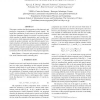Free Online Productivity Tools
i2Speak
i2Symbol
i2OCR
iTex2Img
iWeb2Print
iWeb2Shot
i2Type
iPdf2Split
iPdf2Merge
i2Bopomofo
i2Arabic
i2Style
i2Image
i2PDF
iLatex2Rtf
Sci2ools
ICASSP
2011
IEEE
2011
IEEE
Multichannel harmonic and percussive component separation by joint modeling of spatial and spectral continuity
This paper considers the blind separation of the harmonic and percussive components of multichannel music signals. We model the contribution of each source to all mixture channels in the time-frequency domain via a spatial covariance matrix, which encodes its spatial characteristics, and a scalar spectral variance, which represents its spectral structure. We then exploit the spatial continuity and the different spectral continuity structures of harmonic and percussive components as prior information to derive maximum a posteriori (MAP) estimates of the parameters using the expectation-maximization (EM) algorithm. Experimental results over professional musical mixtures show the effectiveness of the proposed approach.
ICASSP 2011 | Percussive Components | Scalar Spectral Variance | Signal Processing | Spatial Covariance Matrix |
| Added | 21 Aug 2011 |
| Updated | 21 Aug 2011 |
| Type | Journal |
| Year | 2011 |
| Where | ICASSP |
| Authors | Ngoc Q. K. Duong, Hideyuki Tachibana, Emmanuel Vincent, Nobutaka Ono, Rémi Gribonval, Shigeki Sagayama |
Comments (0)

